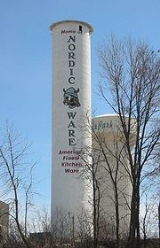
Peavey-Haglin Experimental Concrete Grain Elevator
Encyclopedia
The Peavey–Haglin Experimental Concrete Grain Elevator, built in 1899–1900, was the first circular concrete grain elevator
in the United States, and possibly in the world. It is notable for proving the viability of concrete in grain elevator construction. Previous grain elevators, being built of wood, were expensive to build and vulnerable to fire. The elevator is located near the interchange of Highway 7
and Highway 100
in St. Louis Park, Minnesota
. It was located along the Minneapolis and St. Louis Railway
.
The structure was commissioned by Frank Peavey, owner of a major grain company, and engineered by Charles F. Haglin, a Minneapolis
contractor who also built the Minneapolis City Hall
, the Grain Exchange Building, the Pillsbury Building, and the Radisson Hotel. The elevator was built by pouring concrete into wooden forms braced by steel hoops. The engineers were initially hesitant about how much pressure the structure could withstand, so they ordered the structure capped at 68 feet (20.7 m). After an initial test of filling the elevator and then emptying it proved successful, the elevator was later built to its present height of 125 feet (38.1 m). The inside diameter is 20 feet (6.1 m), and the walls are 12 inches (304.8 mm) thick at the base, tapering to 8 inches (203.2 mm) thick at the top.
After the initial experiments proved successful, the Peavey–Haglin elevator never held grain again, but its design paved the way for more concrete grain elevators across the United States.
The elevator once served as a sign for a lumber store. It now carries the sign for Nordic Ware
.
Grain elevator
A grain elevator is a tower containing a bucket elevator, which scoops up, elevates, and then uses gravity to deposit grain in a silo or other storage facility...
in the United States, and possibly in the world. It is notable for proving the viability of concrete in grain elevator construction. Previous grain elevators, being built of wood, were expensive to build and vulnerable to fire. The elevator is located near the interchange of Highway 7
Minnesota State Highway 7
Minnesota State Highway 7 is a highway in Minnesota, which runs from its intersection with State Highway 28 and Big Stone County Road 1 near Beardsley and continues east to its eastern terminus at its interchange with State Highway 100 and Hennepin County Road 25 in St. Louis Park.For part of its...
and Highway 100
Minnesota State Highway 100
Minnesota State Highway 100 is a state highway in the Twin Cities region of Minnesota, which runs from its interchange with Interstate 494 in Bloomington and continues north to its northern terminus at its interchange with I-694 in Brooklyn Center...
in St. Louis Park, Minnesota
St. Louis Park, Minnesota
As of the census of 2000, there were 44,126 people, 20,782 households, and 10,557 families residing in the city. The population density was 4,122.5 persons per square mile . There were 21,140 housing units at an average density of 1,975.0 per square mile...
. It was located along the Minneapolis and St. Louis Railway
Minneapolis and St. Louis Railway
The Minneapolis and St. Louis Railway was an American Class I railroad that built and operated lines radiating south and west from Minneapolis, Minnesota which existed for 90 years from 1870 to 1960....
.
The structure was commissioned by Frank Peavey, owner of a major grain company, and engineered by Charles F. Haglin, a Minneapolis
Minneapolis, Minnesota
Minneapolis , nicknamed "City of Lakes" and the "Mill City," is the county seat of Hennepin County, the largest city in the U.S. state of Minnesota, and the 48th largest in the United States...
contractor who also built the Minneapolis City Hall
Minneapolis City Hall
Minneapolis City Hall and Hennepin County Courthouse , designed by Long and Kees in 1888, is the main building used by the city government of Minneapolis, Minnesota as well as by Hennepin County, Minnesota...
, the Grain Exchange Building, the Pillsbury Building, and the Radisson Hotel. The elevator was built by pouring concrete into wooden forms braced by steel hoops. The engineers were initially hesitant about how much pressure the structure could withstand, so they ordered the structure capped at 68 feet (20.7 m). After an initial test of filling the elevator and then emptying it proved successful, the elevator was later built to its present height of 125 feet (38.1 m). The inside diameter is 20 feet (6.1 m), and the walls are 12 inches (304.8 mm) thick at the base, tapering to 8 inches (203.2 mm) thick at the top.
After the initial experiments proved successful, the Peavey–Haglin elevator never held grain again, but its design paved the way for more concrete grain elevators across the United States.
The elevator once served as a sign for a lumber store. It now carries the sign for Nordic Ware
Nordic Ware
Nordic Ware is a company based in St. Louis Park, Minnesota that introduced the Bundt cake pan in 1950. It was founded in 1946 by H. David Dalquist....
.

